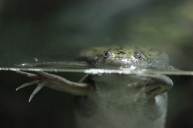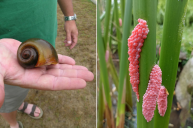Residents of Michigan need to be on the lookout for a new invasive species of plant. While this new plant has already set up what appears to be a permanent residence in the state, experts are hoping to stop it from spreading. The invasive species is known as Japanese Knotweed, and experts are advising those who see this plant in their yard should destroy it immediately.
What Is Japanese Knotweed?

Shutterstock Photo
The Invasive Species Center of California shares some information about the infamous Japanese Knotweed (Fallopia japonica). Although invasive plant species is native to eastern Asia, it was introduced to North America "as a horticultural plant in the late 19th century."
It is a durable plant that can grow in a variety of environments, from wetlands to roadsides or along fence lines. This plant species is so strong that it "has been noted to damage households by growing through concrete cracks." If you are trying to spot this plant, here are some physical descriptors so you know which plant you need to destroy.
The sites are hollow, smooth, and purple to green colored. Its leaves alternate between oval to triangular "with a pointed tip and flat base with a long stalk arising from the stem." The plant produces "small, white-green flowers bloom in sprays near the end of the stems and in the leaf axils in late July or August."
So, now that you know the physical description of this invasive species, let's determine why it is so imperative that you destroy it.
Why You Need To Destroy This Plant
While it doesn't seem like a harmful plant, Japanese Knotweed is not native to the area, and it has been negatively impacting native plants. A local news source shared that "Japanese Knotweed grows aggressively, taking over native plants by blocking sunlight." Additionally, "it releases a chemical to suppress the growth of competing plants."
A spokesperson with the Ottawa Conservation District mentioned why that is problematic. "Our native flowers that are important for pollinators, native plants that insects use to eat that form the basis of our food chains." The invasive species Japanese Knotweed will kill off all of our native plants, affecting our pollinators and the entire food chain system.
Furthermore, do not forget that it is capable of causing structural damage to your home and nearby establishments, as it has no problem growing through concrete.
How You Need To Destroy This Plant

Shutterstock Photo
You've identified it, and now you need to destroy this plant. So, who do you do it? Removing Japanese Knotweed from your property will prove to be a challenge, but it is possible. Experts admit that products like Round-Up have been found to be "94% effective" at killing the invasive species.
That same news source shared that "you need to soak the entire plant depending on the size" but that even with a potent product like Round-Up, "it may take a couple of years before it fully dies off." If you prefer to avoid the use of harsh chemicals on your property, there are some natural, more holistic methods of destroying this plant as well.
A company dedicated to destroying this invasive species shares the following remedies for removing Japanese Knotweed from your premises.
- Corn Gluten Meal
- "It acts as a pre-emergent herbicide by preventing the plant from germinating and establishing itself."
- Vinegar
- "The acetic acid in vinegar is toxic to the plant, killing it quickly and effectively."
- Boiling Water
- "The hot water kills the plant by scalding the roots and leaves, preventing it from regrowing."
- Salt
- "The salt is toxic to the plant, killing it quickly and effectively."
- Lemon Juice
- "The citric acid in lemon juice is toxic to the plant, killing it quickly and effectively."




